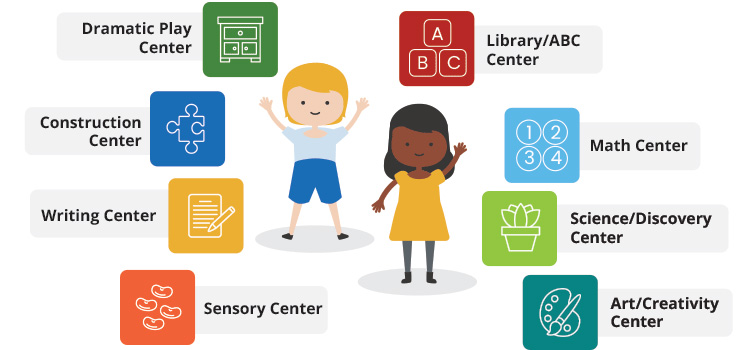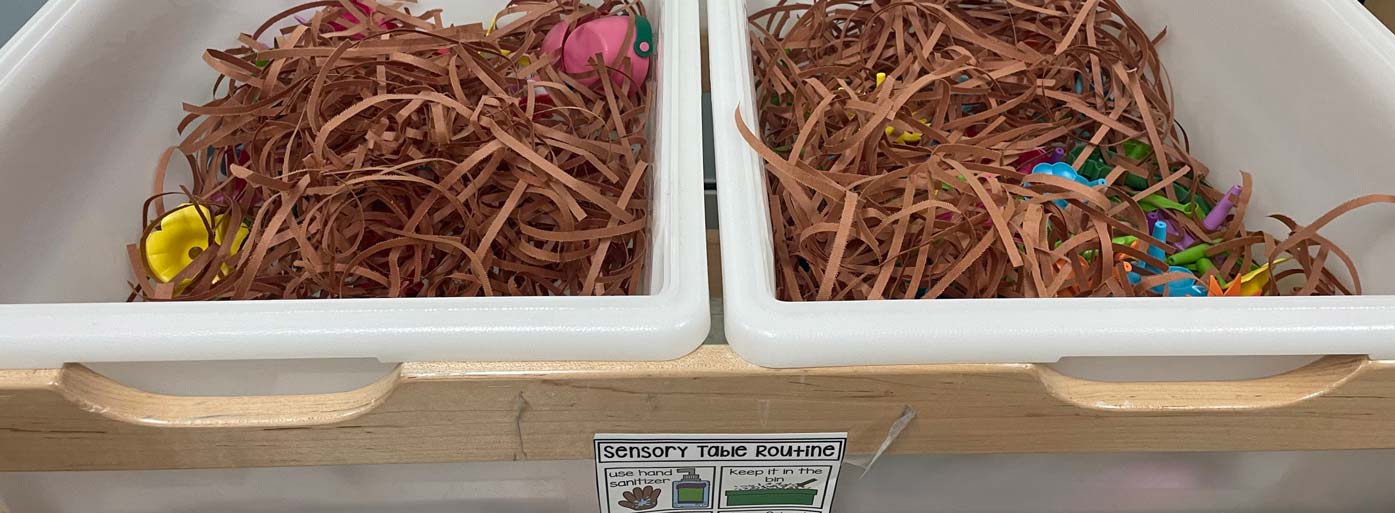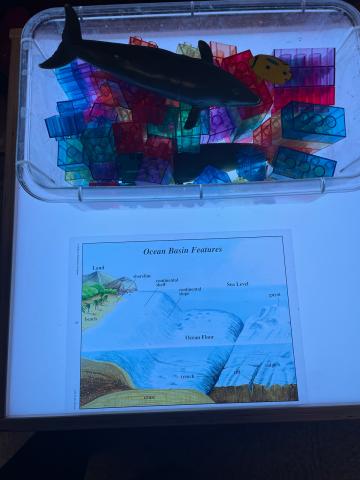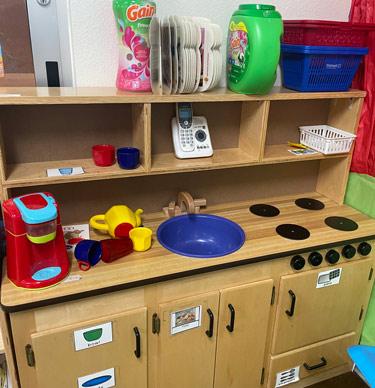Learning Centers in Prekindergarten
The physical arrangement of the preschool classroom includes learning areas designed by the teacher in which students participate in hands-on activities to reinforce already introduced concepts and skills using a wide range of open-ended materials through play. In alignment with developmentally appropriate practices, engagement in learning centers should be freely chosen (e.g., “free choice”) by the child, uninterrupted, and should include the use of a wide variety of materials to support meaningful learning. Learning centers also provide ample opportunities to learn and engage in skills that align with the Texas Prekindergarten Guidelines.
Hands-On Play Centers
The following centers encourage children to engage in hands-on, open-ended, meaningful experiences that support developmentally appropriate play. Please note that the following items/tasks are suggestions and do not include an exhaustive list of materials or activities that can be used in each center:
Download the Learning Center PDF
- Dramatic Play/Pretend and Learn Center: Given appropriate life-like furniture and materials, children are able to learn and pretend play using their own imaginative schema (TPG PK3/PK4.I.C.4).
- Construction Center: Given a variety of different construction blocks, tiles, puzzles, vehicles, and tools, children are able to build structures according to instructional themes and imaginative schema (TPG- PK3/PK4.V.C.2; PK3/PK4.V.E.1).
- Library/Literacy/ABC Center: Given a variety of developmentally appropriate, culturally and linguistically diverse reading material, puppets, and story-telling props, children can build on their motivation to read, write, build print awareness and letter knowledge, and build overall language development. This includes letter knowledge materials such as letter tiles/magnets, interactive letter/sound games, and letter puzzles (TPG- PK3/PK4.II.D.3; PK3/PK4.III.A.2).

- Writing Center: Given a variety of writing tools and fine motor experiences (e.g., lacing, knitting dough, beads, tweezer use), the writing center allows children the ability to engage in the process of practicing fine motor strength and using written expression of ideas, where children can draw and write as a form of communication. Writing activities should include an open-ended, child-led process that does not include the use of worksheets as this is not considered a developmentally appropriate practice. See the Early Childhood Writing Development section in the appendix of the 2022 Texas Prekindergarten Guidelines (TPG- PK3/PK4.IV.A.1; PK3/PK4.IV.A.2)
- Art/Creativity Center: Given a variety of art materials and tools, children are able to individually express themselves through creative, open-ended, artistic means (e.g., not through a teacher-created, craft-made product) (TPG- PK4.VIII.A.1; PK4.VIII.A.2).
- Science/Discovery Center: Given a variety of science and/or nature materials, children can engage in discovery and inquiry with the objects in the world around them (TPG- PK4.VI.A.1, 2, 3).
- Math Center: Given a variety of math materials including manipulatives, counters, numbers, puzzles, etc., children can engage in number sense, geometry, measurement, and classification activities (TPG- PK3/PK4.V.A-E).
- Sensory Center: Given access to tactile materials (e.g., sand, water, pasta, beans, paper, light box, etc.), children can build learning through sensory experiences (TPG- PK3/PK4.V.D.2, PK3/PK4.V.D.3).
Other possible centers that can be utilized in the prekindergarten classroom include:
- STEAM area
- Discovery zone- organic elements and gardening
- Coding and robotics
- Engineering-tinker table/ deconstruction area, light, and sensory zone, Lego wall/table
- Creative arts (music, dance, theater)
The choice of specific learning centers to incorporate in the classroom depends on the availability of the physical space, alignment to adopted instructional materials, and most importantly, the overall needs of the children. Although learning centers may vary in title or even in the physical placement within the classroom, the goal is to ultimately ensure that the purpose of these free-choice areas is to integrate a variety of different learning concepts, opportunities, and experiences. Classroom staff should ensure that all routines and procedures for the care, cleaning, and use of all materials be taught explicitly and modeled for use in the centers. Materials within learning areas can also be increased as routines and procedures become established with students as the school year progresses.
Centers may be broken up into smaller groups given the physical space conducive to learning. For example, a tabletop area may consist of a “Math Center” or “Alphabet Center” that contains corresponding manipulatives. High-quality prekindergarten classrooms will also integrate, books, writing, math, and alphabet materials throughout other centers (e.g., math concepts incorporated into the block area; alphabet concepts incorporated into the writing center, and applicable books placed in every center). In addition, some center areas may be used for multiple purposes such as the whole group area being used as a “music and movement center” or the “Library Center” being used as a “safe space” or “quiet zone.”
Cross Content Play
One concept to consider in the early childhood classroom is cross-area or cross-content play. This includes materials coming together from different areas of the classroom to spark creativity and encourage children’s imaginations. In essence, cross-area play is rooted in the idea that children be given the freedom to experiment with materials in open-ended ways. This can support elaborate play schema and developmental learning opportunities (Minahan, et al. 2021).
Given structure, patience, and flexibility, cross-area play can be successfully implemented through the teaching of routines, procedures, and expectations. Some suggestions are as follows:
- Model and share ideas about using a variety of available tools aligned to the lesson/theme: “What a good idea it would be to wear our safety helmet and vest when building our [block] zoo”; “Perhaps we can use our magnifying glasses to investigate the leaves we glued on our nature collages.”
- Model and remind children of the expectations of “cleaning up” through the use of visual aids and supports (e.g., labeled bins and visual schedules) that promote the organization of all items used out of their ‘living’ center: “Remember our toys need to go back to their homes."
- Use cross-area play as an opportunity to teach responsibility and respect for using classroom community items: “We all take care of our materials so we can continue to share and play with them another day.”
The Role of the Classroom Staff in Learning Centers
Prekindergarten classroom staff members have many roles and responsibilities that may vary during specific parts of the school day. During learning centers, the classroom staff has two primary roles that are vital to child development: communicative interactions and safety and supervision.
Communicative interactions rely on the adult-child relationship that occurs within the context of language and social experiences (e.g., TPG PK3/PK4 II.B.2). During learning centers, the adult has an active role in maintaining a balance of allowing child-led play while also facilitating play experiences that include intentional, rich, positive, language-based interactions (Thunder, et al. 2022). This may look like the adult actively playing with the child, facilitating social interactions between peers, and observing/commenting on the child’s play schemes. Communicative interactions during learning center play also provide the opportunity for staff to gather pertinent observable assessment data to add to a child’s formative assessment portfolio (e.g., taking anecdotal notes, pictures, and/or videos).
The additional role of the prekindergarten classroom staff is to ensure safety and supervision of all children in the classroom. Safety and supervision during learning center play time is crucial to providing a safe environment where children can learn and explore (ECLKC 2022). Learning center time requires all staff to:
- Be vigilant of any physical barriers that prohibit required access to manipulatives.
- Anticipate children’s behavior that requires assistance or redirection (PK3/PK4 I.B.1.c).
- Be aware of problem-solving challenges that may occur between peer-to-peer interactions (PK3/PK4 1.C.5).
- Be actively engaged with children who require additional support (e.g., social-emotional support, physical development adaptations, technology assistance, etc.).
Resources
ECLKC, Head Start/2022. Safety Practices. December 15. Accessed January 19, 2023.
Minahan, Lydia, Jessica Byrd, Sarah Dwyer, Sandra Romp, Viets, Layney, and Ekaterina Strekalova-Hughes. 2021. Sparking Creativity with Cross-Area Play. Teaching Young Children 15 (1).
Thunder, K., J. Almarode, A. Demchak, D. Fisher, and N. Frey. 2022. Making Learning Visible in Early Childhood Through Play. Corwin Connect. October 31. Accessed January 19, 2023.








